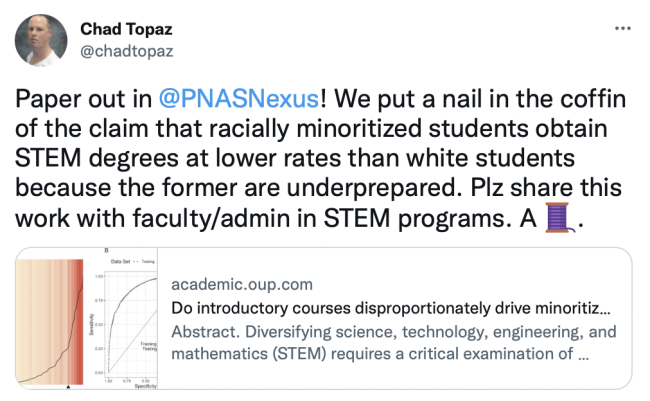You have /5 articles left.
Sign up for a free account or log in.

New study on student success in STEM seeks to end the student-deficit mind-set and put the focus on the system.
Chad Topaz/Twitter
Introductory calculus or general chemistry courses are gateways to science, technology, engineering and math degrees—and careers. Many critics argue they too often serve as grueling gatekeepers instead, turning off students interested in STEM before they have a chance to excel. Prior research has indeed established a relationship between receiving low grades in these introductory courses and a decreased probability of getting a STEM degree. (For what it’s worth, the debate over whether STEM courses weed out too many students isn’t restricted to first-year courses. New York University, for instance, is currently embroiled in a controversy over its dismissal of an organic chemistry instructor whose class students complained was too difficult, per The New York Times.)
A new study doesn’t weigh in on the long-standing gateway-versus-gatekeeper debate, per se. But it does offer evidence that introductory courses in STEM may disproportionately drive out underrepresented minority (URM) students, even after controlling for academic preparation in high school and students’ intent to study STEM.
‘This Is Not What We Observe’
More specifically, the new study in PNAS Nexus finds the association between low performance in an introductory STEM class and failure to obtain a STEM degree is stronger for URM students than for other students, controlling for other variables. To make sense of their logistic models, the authors also calculated predicted probabilities of STEM degree attainment for students of various demographics. They found that a white male student with average academic preparation who receives C or better in all introductory courses has a 48 percent chance of getting a STEM degree, compared to 35 percent for an otherwise similar female URM student. Should these hypothetical students receive a grade lower than C in just one introductory STEM course, their respective chances of getting a STEM degree drop to 33 percent and 21 percent.
Such findings, of course, fly in the face of widespread efforts to diversify STEM and make higher education over all more equitable.
As the paper says, “introductory STEM courses are institutional structures that may exacerbate disparities in STEM education and, as such, equity issues must be central in efforts to redesign and rebuild them.” Co-author Chad Topaz, professor of complex systems at Williams College and co-founder of the Institute for the Quantitative Study of Inclusion, Diversity, and Equity, also said on Twitter that “we put a nail in the coffin of the claim that racially minoritized students obtain STEM degrees at lower rates than white students because the former are underprepared.”
For context, one 2020 study found that Black, Hispanic and Indigenous persons were 30 percent of the U.S. population, 34 percent of STEM-intending incoming college students and just 18 percent of undergraduate STEM degree recipients in 2017. Wanting to understand the discrepancy between these numbers, Topaz and his colleagues created models based on data from six large public institutions included in an existing database called Multiple Institution Database for Investigating Engineering Longitudinal Development. Their sample included high school grade point average, ACT composite score, STEM degree intent and undergraduate grades for more than 100,000 students who started college from 2005 to 2012.
Across the sample, the STEM degree attainment rate was 16 percent. Of students who took at least one STEM course in their first term, 72 percent had no D, F or withdraw grades. Twenty percent had one DFW grade, and the remaining 8 percent had two or more DFWs.
Analyzing the effect of race, the authors found that for students with no DFWs (and controlling for other factors), a white woman, an Asian woman and a URM woman have probabilities of STEM degree attainment that are only 0.658, 0.803 and 0.492 times as large as for a white man. Put another way, it is 1.52, 1.25 and 2.03 times less probable, respectively, for these female students to get a STEM degree as compared to a white male student. For male and female URM students, respectively, the probability of obtaining a STEM degree is 0.636 and 0.748 times that of a white counterpart.
Regarding the interaction of URM status and DFWs, the authors found a differential impact. Male URM, female URM and white female students with one DFW have probabilities of getting a STEM degree more similar to those of white men, Asian men and Asian women with two DFWs. And Black students with no DFWs have similar probabilities of attaining STEM degrees as white male students with one or two DFWs.
Moving Beyond the ‘Fixing Students’ Mentality
“In an equitable education system, students with comparable high school preparation, intent to study STEM, and who get Cs or better in all their introductory STEM courses ought to have similar probabilities of attaining a STEM degree. This is not what we observe,” the study says, as white male students with this profile have the highest probability of obtaining a STEM degree (that 48 percent) while female URM students are the least probable STEM graduates (that 35 percent). “Our study shows that we need to move beyond the ‘fixing students’ mentality. We suggest as a starting point the critical reflection and examination of department, school, college, and university policies and cultures.”
Matthew Salomone, interim associate dean of science and mathematics and professor of math at Bridgewater State University in Massachusetts, who was not involved in the study, said Monday that the results grabbed his attention because he’s been involved in National Science Foundation–funded efforts on his own campus to increase STEM retention by building supports for student success in introductory courses.
Salomone said that his own work with colleagues suggested that Bridgewater State’s peer-instruction program drove introductory course success “primarily by mitigating the disparities in outcomes that were previously associated with students’ academic entry factors—for example, standardized test scores.” Topaz’s article helped illuminate the dynamics at play in STEM retention via its large, multi-institution data set, its controls for academic preparation (what Salomone calls entry factors) and its setting the stage for further study of introductory course success and STEM major “flourishing,” Salomone added.
“It addresses head-on the unfortunate tendency to use low test scores as an excuse not to confront the unequal outcomes experienced by students of color in a STEM pipeline seemingly designed to leak them out,” he said. “It implicates introductory-course pedagogy as part of that problem, and therefore, happily, part of the solution.”
Topaz told Inside Higher Ed that “if you have two students who quote-unquote ‘look the same on paper,’ who both earn a DFW in an intro STEM course, but one is white and one is URM, the decrease in probability of STEM degree attainment is more severe for the URM student.” As for what drives this difference, Topaz said this was outside the scope of this particular study, but that the education literature already has a lot to say about “implicit signaling to students, stereotype threat, support networks, broader socioeconomic trends and more.”
In any case, Topaz said his findings should put a stop to stop to “student deficit” thinking.
“The fact that we have controlled for high school preparation in our model means that the lower STEM degree attainment rates of URM students shouldn’t be blamed on those students’ level of preparedness,” he said. “Simply put, the system treats a URM student differently than an otherwise-comparable white student, so the system needs to be changed.”









